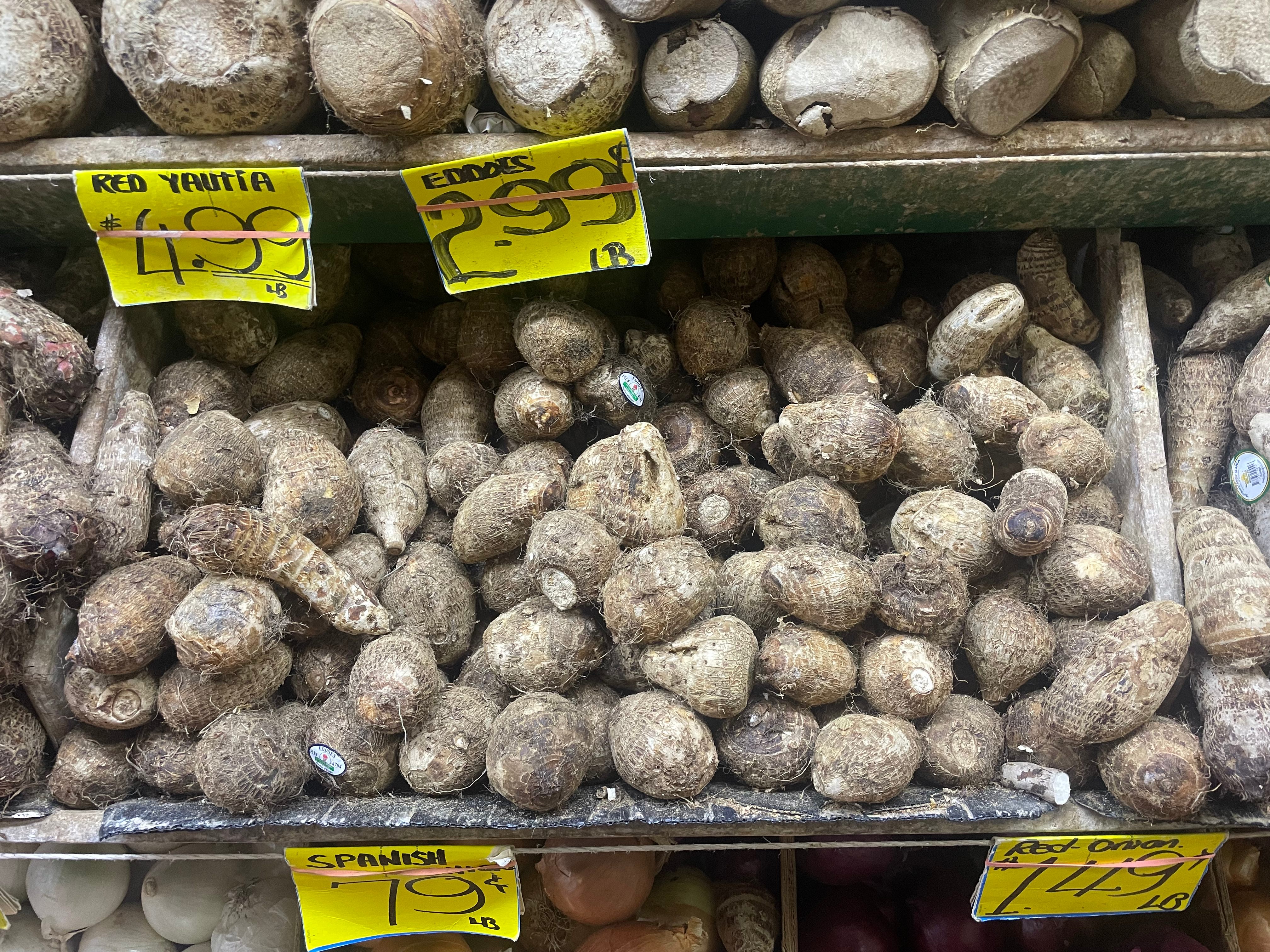The Confusing Truth About Arrowroot
What’s in a name?
THIS ARTICLE IS ADAPTED FROM THE JANUARY 20, 2024, EDITION OF GASTRO OBSCURA’S FAVORITE THINGS NEWSLETTER. YOU CAN SIGN UP HERE.
While the common names of plants and animals vary around the globe, their scientific names stay the same everywhere. Scientific nomenclature is not without issues (like India’s native curry leaf being named in honor of two European botanists), but it can be a helpful tool for identifying ingredients, especially international groceries from non-English speaking countries. Such products may be labeled with the wrong English name (I once bought “fennel seeds” from a Chinese store that turned out to be cumin), or with their scientific name in place of the English name, like Auricularia instead of wood-ear mushroom. And some ingredients are so locally specific that their “common English name,” even if it’s used, is not so common. English rock samphire probably doesn’t ring any more bells than kritamos, the native name for the Greek edible plant Crithmum maritimum.
Then, there’s the case of different ingredients that share a common English name. Take the example of arrowroot. While you may encounter arrowroots sold as vegetables, arrowroot starch is its most-common commercial form, also called arrowroot flour or powder. But the shocking truth is that there is no one arrowroot plant. There are actually around 10 edible plants that may be referred to as arrowroot; a quiverful of them, if you will. Each has its own scientific name and its own culinary uses. With a little help from scientific nomenclature, Gastro Obscura is here to explain one of the least-straightforward terms in food.
West Indian arrowroot (Maranta arundinacea)
This rainforest plant with an edible rhizome has been cultivated in South America and the Caribbean for as long as 7,000 years. While some sources claim that the name arrowroot comes from the Indigenous Arawak term aru-aru, meaning “meal of meals,” others say it comes from an early medicinal use, as a poultice to draw the toxins from poisoned arrow-wounds.
In the 1800s, M. arundinacea started to be grown on a large scale for its starch in tropical regions of the Americas. Nineteenth-century American cookbooks feature recipes for milky puddings and blancmanges thickened with arrowroot starch, which works similarly to cornstarch as a binding agent. Since then, the popularity of this plant as a source of starch led other plants to be given the same common name. If it’s a root used to produce starch, somebody has probably called it arrowroot at some point.
Some companies, such as Bob’s Red Mill, identify their arrowroot powder as coming from Maranta arundinacea. Other commercial arrowroot starch comes from related South American species in the genus Maranta, and it’s not always possible to know which one you’re getting. All of them have similar properties in cooking, so as long as the name Maranta is indicated on packaging you can feel confident that you’re using the “original” arrowroot.
Florida arrowroot (Zamia integrifolia)
Also called the coontie palm, this North American cycad was a traditional source of food and starch for Indigenous people in what is now Florida. In the 19th century, a local industry developed around Zamia starch powder, branded as “Florida arrowroot” to rival the Maranta starch produced in other regions. However, because Zamia is highly toxic without significant processing, its starch was deemed unsafe and banned by the FDA in 1925. Today, Florida arrowroot is sold only as an ornamental garden plant.
East Indian arrowroot (Cucurma angustifolia)

This arrowroot lacks the intense color of its close cousin, turmeric. It’s native to the Indian subcontinent, especially northeastern regions of India such as Manipur, where its artichoke-like flowers are split, fried, and eaten. In other parts of India, where it’s known as tikhur, among other names, it’s more commonly encountered as a medicine or starch powder rather than a vegetable. Tikhur sherbat is a sweet summertime beverage thickened with arrowroot starch and jellylike basil seeds that’s flavored with rock sugar and edible tree resin.
Japanese or Chinese arrowroot (Pueraria species)

Many English speakers know the climbing vines of the genus Pueraria by another common name: kudzu, from Japanese kuzu, infamous in North America because one species has become highly invasive there as “the vine that ate the South.” But in its native East Asia, kudzu has long been used for weaving, medicine, and cuisine. It is one of many plants mentioned in The Pillow Book, a work of Japanese poetry from 1000 AD. The starch can be used to make chewy or bouncy desserts like true arrowroot starch, and the hard, mild-tasting roots, distinctive due to their pronounced lengthwise ridges, can be prepared like potatoes, though they take longer to cook.
Chinese arrowroot or arrowhead (Sagittaria trifolia)

Native to China, this aquatic plant’s scientific name, Sagittaria, also alludes to arrows; think of Sagittarius, the Archer. In this case, the name comes from the triangle shape of the plant’s leaves. In Mandarin it’s called cí gu, meaning “arrowhead.” It’s a relative of the wild edibles wapato and katniss, both native to North America. The nutritious rounded bulbs of Sagittaria (labeled as “arrowroot” at my local Chinese grocery store) are not used to produce starch commercially, and are different in appearance from true arrowroot. They taste similar to potato but are more crunchy and have to be cooked for a long time to soften them.
Polynesian arrowroot (Tacca leontopetaloides)

Pacific Islanders once painstakingly processed starch from the hard, bitter tubers of the plant they called pia, mixing it with coconut milk and fruit or sugarcane juice and steaming it to create traditional sweets. This was the original form of haupia, a Hawaiian coconut jelly typically made with cornstarch today. When Europeans arrived in the region, they dubbed this plant yet another “arrowroot” after the Maranta plant they were familiar with. Cornstarch and other thickeners have largely replaced Polynesian arrowroot, and it is now rarely cultivated, though some continue to do so as part of their cultural heritage.
Arrowroot (Thalia geniculata)
Much like Sagittaria, this plant is aquatic, not used to produce starch commercially, and got the name simply because it has arrow-shaped leaves. Other names include “swamp lily” and “bent alligator-flag.” Widespread in tropical regions, it is foraged as food but not cultivated, and there’s little information available about its nutritional value. Thalia leaves may be used to wrap dishes for cooking, while its small roots turn pink when cooked, causing some to compare them to shrimp in appearance. The flavor, on the other hand, is said to be “swampy.”
Brazilian arrowroot or cassava (Manihot esculenta)
Maranta is native to Brazil, making the term “Brazilian arrowroot” for this plant redundant. It’s even more unnecessary when you consider that Manihot esculenta already has plenty of common English names, such as cassava, yuca, and manioc. This plant originated in South America but is now widely cultivated in tropical regions.
Cassava flour or “starch” is sometimes labeled as arrowroot, but it’s produced by grinding dried cassava roots and can be consumed as a staple ingredient, not just used as a thickener. And if you squeeze the juice from fresh cassava roots and collect the pure starch that settles at the bottom, you’ve got tapioca, a starch with a bouncier, stretchier texture than either cassava flour or true arrowroot starch.
Taro (Colocasia esculenta)

Taro got esculenta added to its scientific name for the same reason as cassava: The word means “edible” in Latin. It’s frequently referred to as or confused with arrowroot, especially the small, hairy, round taro varieties with smooth white flesh, rather than the bigger, longer types, which may be purple or flecked with spots inside.
As with cassava, taro flour is not typically sold as a binding agent, but as an ingredient itself, for example to produce an instant version of the Hawaiian staple poi. Taro is native to the Pacific and was first cultivated alongside Polynesian arrowroot by Pacific Islanders (who had no trouble telling the two apart).
Gastro Obscura covers the world’s most wondrous food and drink.
Sign up for our email, delivered twice a week.































Follow us on Twitter to get the latest on the world's hidden wonders.
Like us on Facebook to get the latest on the world's hidden wonders.
Follow us on Twitter Like us on Facebook